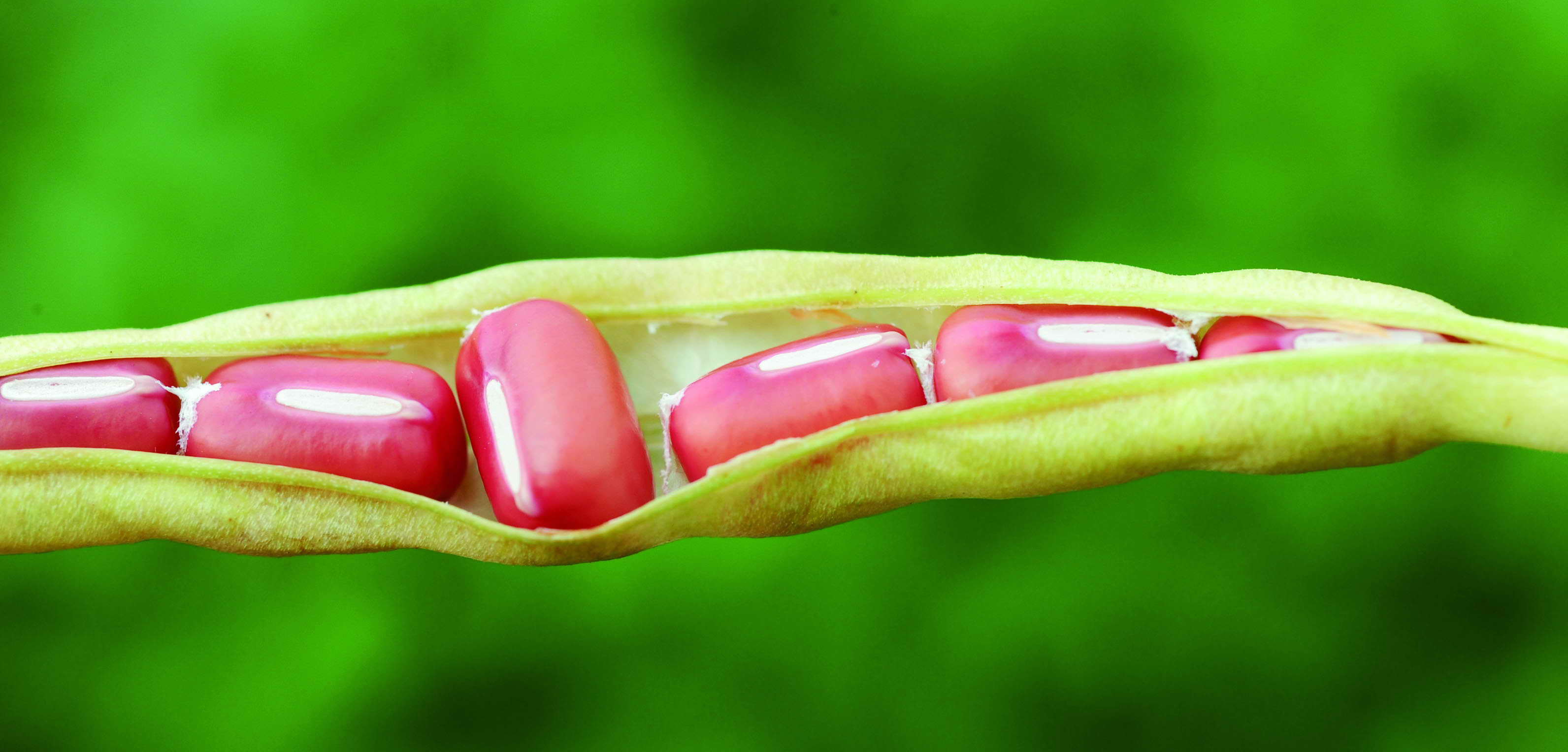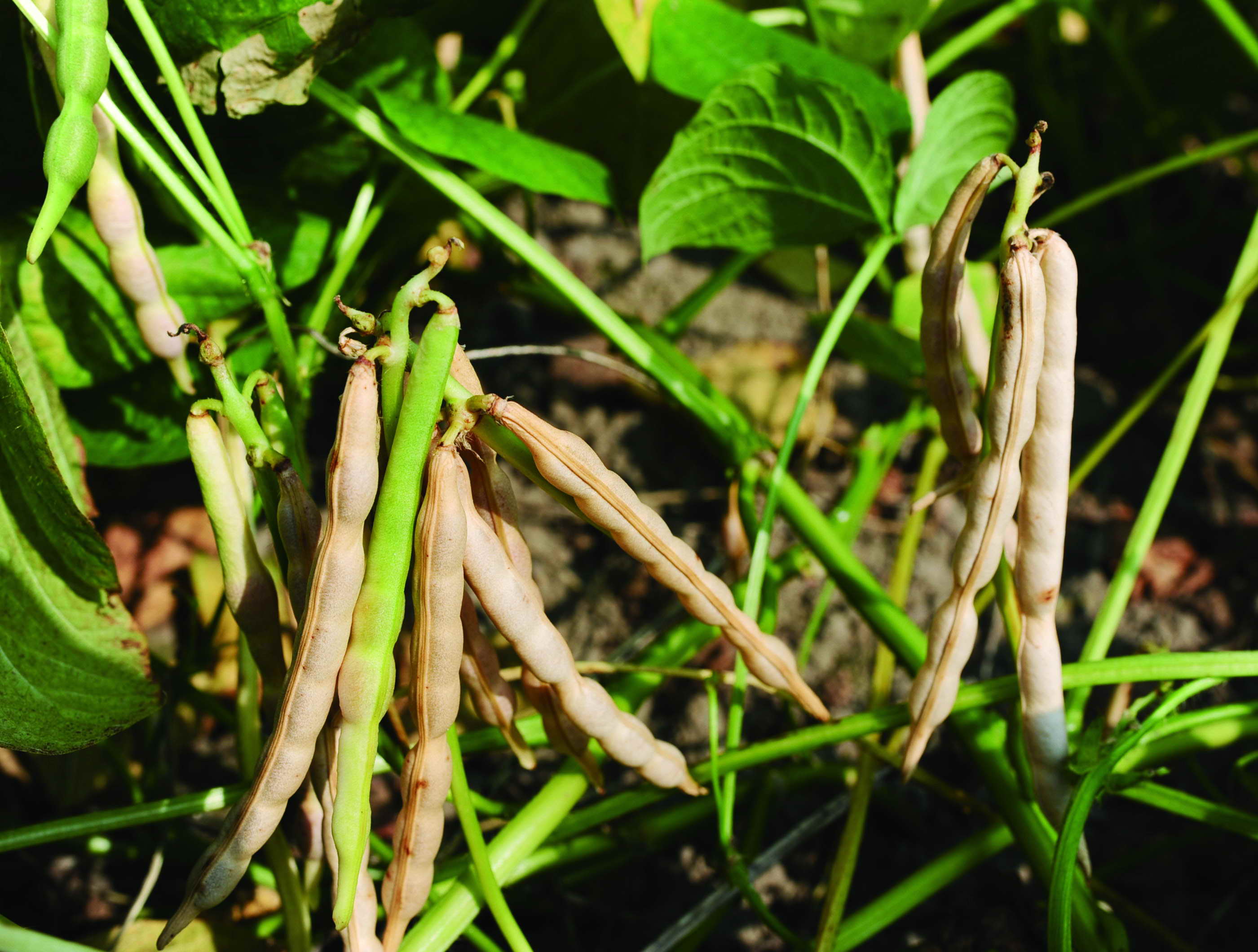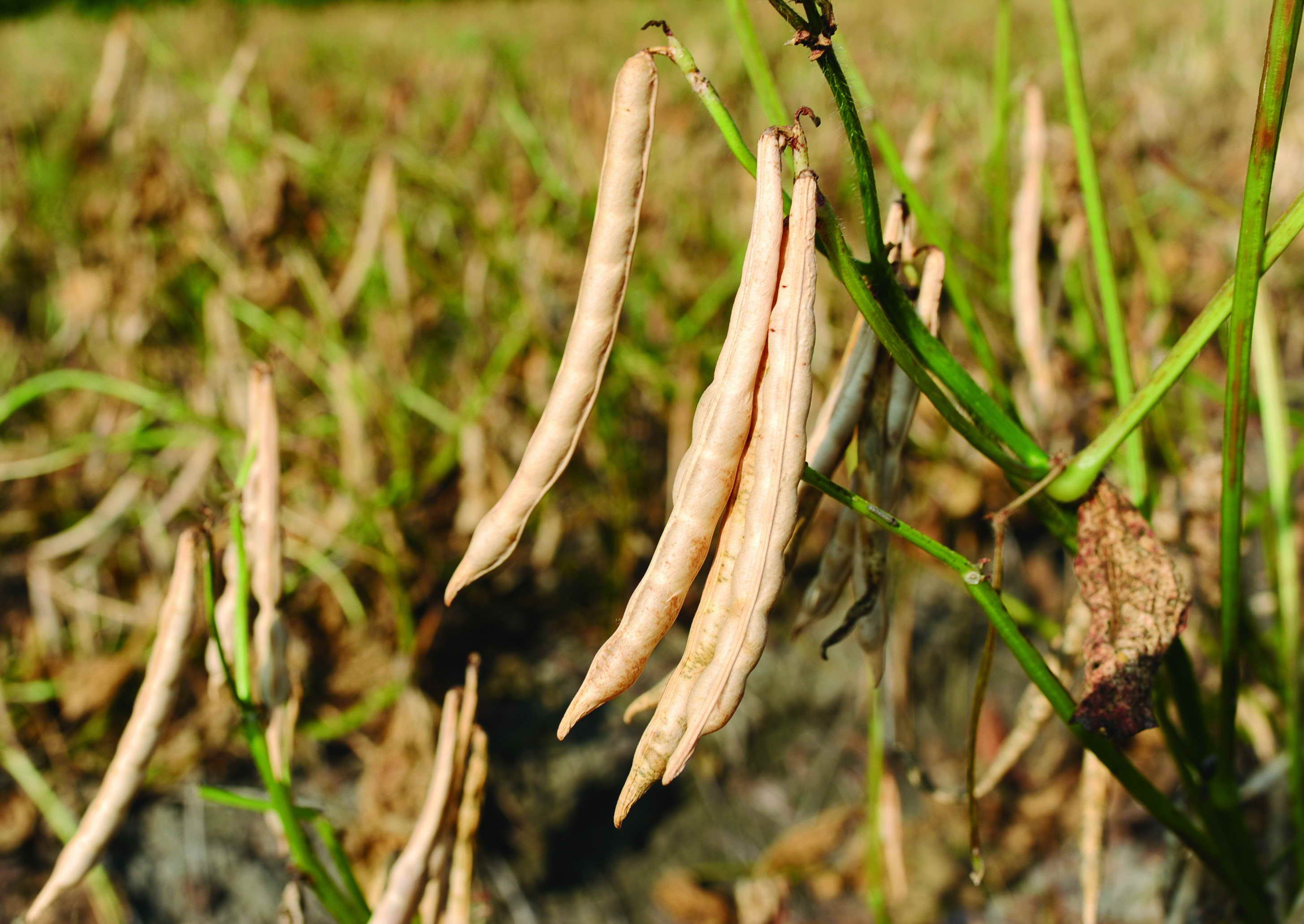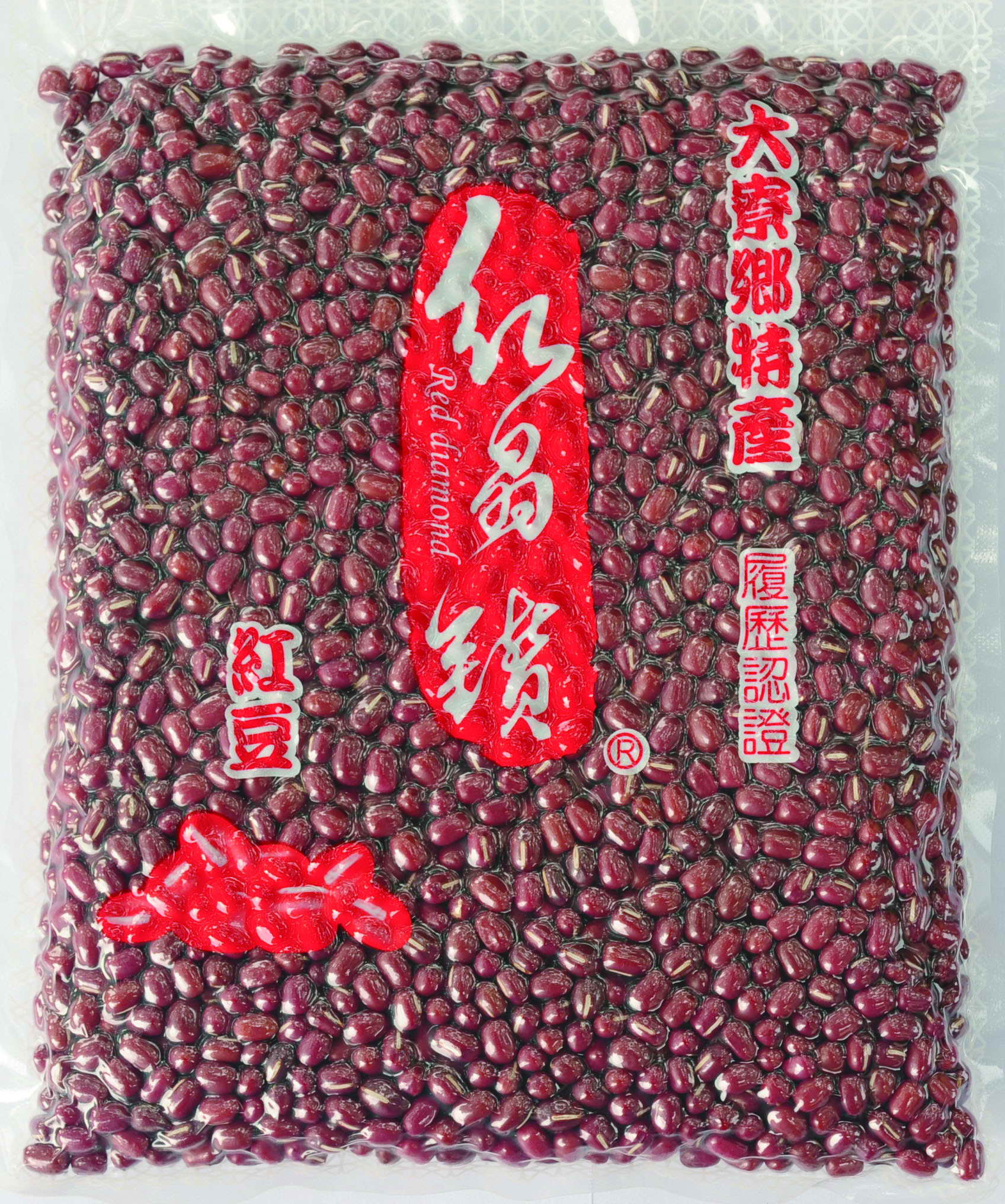Pride of Daliao District: Red Diamond Adzuki Beans / 大寮 紅晶鑽紅豆
Pride of Daliao District: Red Diamond Adzuki Beans
◎English translation: Tan Shu-chun ◎Photos by Pao Chung-hui
 No grains grow better in the fertile soils of the Kaohsiung-Pingtung region than adzuki beans. Grown in autumn and harvested in winter, adzuki beans need warm weather to reach maturity, and the Kaohsiung-Pingtung area provides perfect weather conditions for their cultivation.
No grains grow better in the fertile soils of the Kaohsiung-Pingtung region than adzuki beans. Grown in autumn and harvested in winter, adzuki beans need warm weather to reach maturity, and the Kaohsiung-Pingtung area provides perfect weather conditions for their cultivation.
As soon as rice is harvested in May and June, farmers in Kaohsiung's Daliao District prepare for the adzuki season by improving soil fertility with green manure. After planting in late September, the adzuki seeds start to absorb south Taiwan's warm sunlight. The initial growing phase requires temperatures above 30 degrees Celsius. The beans continue to mature in their pods during the middle and final growing phases for another 115 days, during which cooler temperatures of around 25 degrees Celsius are ideal. Once the leaves turn yellow and start to fall, the beans - by this time they are giving off a distinctive fresh aroma - are ready to be removed from the mature pods.
 Daliao District's adzuki production and sales organization has launched a new brand name, "Red Diamond," which is synonymous with perfect color and luster. To ensure high-quality output, the organization has chosen to grow two strains of adzuki beans awarded food-traceability certification, Kaohsiung No.8 and Kaohsiung No.9. Water, soil, pesticides and fertilizers are used in compliance with regulations and samples are sent for inspection both before and after the beans reach maturity. Every effort is made to ensure consumers enjoy adzuki beans of the highest quality.
Daliao District's adzuki production and sales organization has launched a new brand name, "Red Diamond," which is synonymous with perfect color and luster. To ensure high-quality output, the organization has chosen to grow two strains of adzuki beans awarded food-traceability certification, Kaohsiung No.8 and Kaohsiung No.9. Water, soil, pesticides and fertilizers are used in compliance with regulations and samples are sent for inspection both before and after the beans reach maturity. Every effort is made to ensure consumers enjoy adzuki beans of the highest quality.
Daliao's adzuki production and sales organization was established in 2006; in 2010, it registered "Red Diamond" as a trademark. The organization aims to establish the brand as a locally-produced premium product. In 2012, around 330 hectares in Daliao District were planted with adzuki beans, with Kaohsiung No. 9 beans being the prime type. A hundred grains of Kaohsiung No.9 beans weigh about 21.5 grams. Mr. Wang Rei-jung, the organization's leader, says that each step in the growing process - including the choice of bean type, soil, water, ecological farming and management - is subject to careful inspection to ensure Daliao's adzuki beans are the best possible.
 Mr. Wang is himself an adzuki farmer, and the leaves of the adzuki plants in his field all have a healthy shine. An adzuki plant can grow more than a hundred of pods, with eight beans per pod. Although adzuki beans are tiny, cultivating them is not simple. Adzuki beans prefer sandy soils; farmers apply multiple biological-control methods to keep pests at bay. One of these is applying neem oil, the pungent odor of which repels pests and bugs.
Mr. Wang is himself an adzuki farmer, and the leaves of the adzuki plants in his field all have a healthy shine. An adzuki plant can grow more than a hundred of pods, with eight beans per pod. Although adzuki beans are tiny, cultivating them is not simple. Adzuki beans prefer sandy soils; farmers apply multiple biological-control methods to keep pests at bay. One of these is applying neem oil, the pungent odor of which repels pests and bugs.
 Ms. Chen Yu-ju, an assistant researcher who has been working in Kaohsiung District Agricultural Research and Extension Station for over two decades, draws a comparison between locally-produced adzuki beans and imported adzuki beans. Locally produced beans are generally equal in size and give off a strong aroma, while foreign beans vary in size and are darker. Due to price spikes for foreign beans and freight costs, local food companies have embraced local adzuki beans, as a result of which the supply of local adzuki beans cannot meet export demands.
Ms. Chen Yu-ju, an assistant researcher who has been working in Kaohsiung District Agricultural Research and Extension Station for over two decades, draws a comparison between locally-produced adzuki beans and imported adzuki beans. Locally produced beans are generally equal in size and give off a strong aroma, while foreign beans vary in size and are darker. Due to price spikes for foreign beans and freight costs, local food companies have embraced local adzuki beans, as a result of which the supply of local adzuki beans cannot meet export demands.
The latest crop of Daliao's adzuki beans will be harvested between early January and early February 2013. If you want to taste the best and freshest adzuki beans, "Red Diamond" is your ideal choice.
Daliao adzuki beans are available from Daliao District Farmers' Association (tel: 07-7811141).
大寮 紅晶鑽紅豆
◎文/侯雅婷 ◎攝影/鮑忠暉
 再沒有比紅豆這一項雜糧作物更適合栽種在高屏區的沃土,紅豆是在秋天播種、冬天收成,高屏地區恰如其份地提供了栽植紅豆所需先高溫再冷涼的氣候。
再沒有比紅豆這一項雜糧作物更適合栽種在高屏區的沃土,紅豆是在秋天播種、冬天收成,高屏地區恰如其份地提供了栽植紅豆所需先高溫再冷涼的氣候。
5至6月結束稻作後,大寮區的農民開始栽植綠肥、養地,為接續下來的紅豆積蓄能量,9月下旬播種後,蟄伏土裡的紅豆,吸納了高屏地區的日照,初期需要高達三十度以上的高溫,等到生長的中下期,豆莢正蘊孕充實飽滿的紅豆,此時需要25度冷涼的溫度,紮紮實實地蘊孕115天,等待葉子自然轉黃、脫落,紅豆完熟,從鼓鼓的豆莢取出豆子,散發出新鮮的香氣。
高雄大寮區紅豆產銷班推出「紅晶鑽 」紅豆品牌,顆顆顏色鮮紅、充滿光澤 ,紅豆圓潤、飽滿,為了替消費者把關 ,大寮區產銷班取得產銷履歷認證栽種的品種「高雄8號」和「高雄9號」,從水、土壤,乃至於農藥、肥料的使用,均須依規定按時使用和在成熟前、後的兩個時間點送驗,讓消費者吃得安心。
 大寮區紅豆產銷班自2006年成立,2010年註冊「紅晶鑽」紅豆品牌,讓消費者安心享受在地生產最優質的紅豆。大寮區2012年紅豆栽種面積約330公頃 ,主要以栽種紅豆9號為大宗。紅豆9號品種,每100粒(紅豆)重達約21.5公克 ,產銷班班長王瑞榮表示,大寮紅豆品質之所以能達至上乘,從紅豆品種、土壤、水質、生態農法到管理,層層把關 ,樣樣都得講究。
大寮區紅豆產銷班自2006年成立,2010年註冊「紅晶鑽」紅豆品牌,讓消費者安心享受在地生產最優質的紅豆。大寮區2012年紅豆栽種面積約330公頃 ,主要以栽種紅豆9號為大宗。紅豆9號品種,每100粒(紅豆)重達約21.5公克 ,產銷班班長王瑞榮表示,大寮紅豆品質之所以能達至上乘,從紅豆品種、土壤、水質、生態農法到管理,層層把關 ,樣樣都得講究。
觀察王班長的紅豆田,葉片亮麗、一株紅豆10號的品種甚至能結出上百個豆莢,每個豆莢可長出8顆紅豆。小小一顆紅豆,學問很大,王班長指出,紅豆被栽種在最適合紅豆生長的砂質土壤,至於病蟲害防治採生物性防治,比如以苦楝油提煉出用藥,從味道等多種管道驅趕害蟲。
 高雄區農改場研究紅豆超過二十年的助理研究員陳玉如分析,台灣紅豆與外國紅豆的品質兩者相較之下,台灣紅豆大小均勻、香味很濃,而國外紅豆大小不一、顏色較暗沉,國內食品大廠這幾年在國外紅豆價格上揚再加上運費,使得由國外進口紅豆與國產紅豆價格相當 ,廠商轉而訂購品質更新鮮的國產紅豆 ,國內的紅豆因市場內需已供不應求,更遑論外銷。
高雄區農改場研究紅豆超過二十年的助理研究員陳玉如分析,台灣紅豆與外國紅豆的品質兩者相較之下,台灣紅豆大小均勻、香味很濃,而國外紅豆大小不一、顏色較暗沉,國內食品大廠這幾年在國外紅豆價格上揚再加上運費,使得由國外進口紅豆與國產紅豆價格相當 ,廠商轉而訂購品質更新鮮的國產紅豆 ,國內的紅豆因市場內需已供不應求,更遑論外銷。
大寮區紅豆採收時間約為2013年1月初至2月初,想品嚐當令新鮮紅豆,首選大寮區「紅晶鑽」紅豆。
哪裡買?
大寮區農會 07-7811141